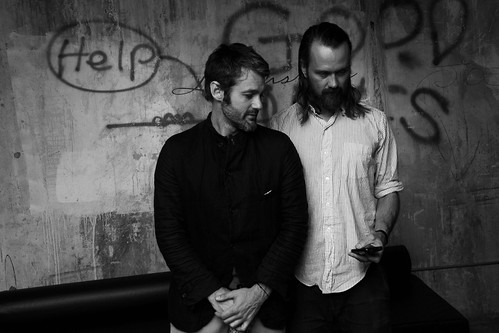Last week, I had the chance to sit down with Scott Mackinlay Hahn, one half of the design duo behind the eco clothing line, Loomstate. I really looked forward to chatting with him not only because he is insanely gorgeous, but because he has a deep passion for bringing awareness to some of the problems that face sustainability.
Since it is Earth Day, I must be completely transparent: I found this interview to be one of the most challenging ones that I have done so far. When I sat down to think up my questions, I realized just how uneducated I was on sustainable fabric or "green fashion" as some would call it. I also realized that I am not alone in the confusion surrounding good sustainable practices, and that is one of the biggest road blocks in making eco-friendly fashion the standard instead of just a passing trend.
I did video the interview, but unfortunately it was too dark at the event for the picture to show clearly. However, I do hope that you take a few minutes today to read the transcript of this interview.
Happy Earth Day! Thank you for joining me for this interview. Could you explain how important it is to have organic fabrics and the process behind producing them?
First, organic is a tricky word, so is sustainability, so there is a lot of information that needs to be brought to the surface here. Fundamentally, the fiber origin is usually agriculture, if it's natural fiber. So you look at the farming process: are they using gmoc, synthetic fertilizers, pesticides in the cultivation of primarily cotton.. This is all about soil fertility. You're talking about preserving the ability to grow things and to have food and fiber and crop rotation going forward not just for our generation but for future generations. You don’t realize the demands that our society is putting on soil. So by paying attention to that, you start looking at ways to balance it out and there are a lot of ways around poisoning the soil.
Then you look at synthetic fiber and trying to avoid fossil fuels and petroleum based fibers. Looking at how to use recycled concepts, and a lot of the stuff that’s going on with the nylons, and rayons, it's about waste and what chemicals are off gasing. You kind of, from a production standpoint, you get real educated about this and you hold the suppliers accountable. You want to know content, you ask about the footprint. And slowly as it moves up the chain to the market, you want to communicate as simply to the customer as you can to educate them. The big idea is traceability and transparency so that customers, merchants, and production managers at fashion companies can be informed in their purchases.
How important is it for the government to get involved to help regulate or invest in textile development?
Policy is an important step in regulating progressions in the market. With free market concepts, unfortunately, we are a rational but self-interested species so a company has the ability to marginalize the people they are selling to for more profit...somehow that always happens. That’s where the policy and regulation comes in and without it, things get a little crazy. You’ve heard common pool resource dilemmas where u have a certain amount of land where herdsmen are grazing their cows and sheep and if they’re all left to eat as much and add more sheep and add more sheep for more profit, eventually there’s no more grass. You need rules in place so that various herdsmen can share that common resource. That concept is where rules and laws come in so everyone knows how to play. So yea, that’s a long answer, but policy is a big part of what we are doing.
It's all about responsibility. It's about feeling gratified about what you are putting in your closet and your body. It’s all connectied and that’s the big idea at Loomstate. It's trying to show people that from the farm all the way to the kitchen table and your wardrobe, that it's all connected. It also has the ability to be designed in a way that is pretty special and sexy.
A lot of people think that going green means things will be more expensive. Is that the case?
In some cases it can be a little bit more expensive to produce because of the supply and demand or the ability of resources. It does sometimes cost factories more to retool and bring a cleaner product to the market. Once the tipping point occurs and the majority of America wants this stuff because it matters to them or it's an important value to the family or to college kids, we will see change a lot faster. Eventually it wont be about green fashion, that will be the price of entry. Green fashion is a way to think of it , but for us it is good design.
For more about Rogan and Scott's line, Loomstate, go to Loomstate.org
They also are having a sale on Gilt Groupe today for Earth Day! Here is an exclusive invite code for you! INVITE CODE
Stay Green,
SG


















No comments:
Post a Comment